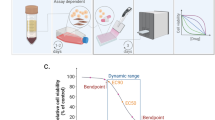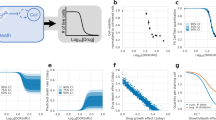Abstract
The fluorometric microculture cytotoxicity assay (FMCA) is a nonclonogenic microplate-based cell viability assay used for measurement of the cytotoxic and/or cytostatic effect of different compounds in vitro. The assay is based on hydrolysis of the probe, fluorescein diacetate (FDA) by esterases in cells with intact plasma membranes. The assay is available as both a semiautomated 96-well plate setup and a 384-well plate version fully adaptable to robotics. Experimental plates are prepared with a small amount of drug solution and can be stored frozen. Cells are seeded on the plates and cell viability is evaluated after 72 h. The protocol described here is applicable both for cell lines and freshly prepared tumor cells from patients and is suitable both for screening in drug development and as a basis for a predictive test for individualization of anticancer drug therapy.
This is a preview of subscription content, access via your institution
Access options
Subscribe to this journal
Receive 12 print issues and online access
$259.00 per year
only $21.58 per issue
Buy this article
- Purchase on Springer Link
- Instant access to full article PDF
Prices may be subject to local taxes which are calculated during checkout



Similar content being viewed by others
References
Blumenthal, R.D. An overview of chemosensitivity testing. Methods Mol. Med. 110, 3–18 (2005).
Larsson, R., Kristensen, J., Sandberg, C. & Nygren, P. Laboratory determination of chemotherapeutic drug resistance in tumor cells from patients with leukemia, using a fluorometric microculture cytotoxicity assay (FMCA). Int. J. Cancer 50, 177–185 (1992).
Larsson, R., Nygren, P., Ekberg, M. & Slater, L. Chemotherapeutic drug sensitivity testing of human leukemia cells in vitro using a semiautomated fluorometric assay. Leukemia 4, 567–571 (1990).
Rubinstein, L.V. et al. Comparison of in vitro anticancer-drug-screening data generated with a tetrazolium assay versus a protein assay against a diverse panel of human tumor cell lines. J. Natl. Cancer Inst. 82, 1113–1118 (1990).
Dhar, S. et al. Anti-cancer drug characterisation using a human cell line panel representing defined types of drug resistance. Br. J. Cancer 74, 888–896 (1996).
Fridborg, H., Jonsson, E., Nygren, P. & Larsson, R. Relationship between diagnosis-specific activity of cytotoxic drugs in fresh human tumour cells ex vivo and in the clinic. Eur. J. Cancer 35, 424–432 (1999).
Hjarnaa, P.J. et al. CHS 828, a novel pyridyl cyanoguanidine with potent antitumor activity in vitro and in vivo. Cancer Res. 59, 5751–5757 (1999).
Lindhagen, E. et al. Pharmacological profiling of novel non-COX-inhibiting indole-pyran analogues of etodolac reveals high solid tumour activity of SDX-308 in vitro. Invest. New Drugs 25, 297–303 (2007).
Wickstrom, M. et al. The novel alkylating prodrug J1: diagnosis directed activity profile ex vivo and combination analyses in vitro. Invest. New Drugs 26, 195–204 (2007).
Fryknas, M. et al. Phenotype-based screening of mechanistically annotated compounds in combination with gene expression and pathway analysis identifies candidate drug targets in a human squamous carcinoma cell model. J. Biomol. Screen. 11, 457–468 (2006).
Hassan, S.B., Jonsson, E., Larsson, R. & Karlsson, M.O. Model for time dependency of cytotoxic effect of CHS 828 in vitro suggests two different mechanisms of action. J. Pharmacol. Exp. Ther. 299, 1140–1147 (2001).
Lindhagen, E. et al. R-etodolac (SDX-101) and the related indole-pyran analogues SDX-308 and SDX-309 potentiate the antileukemic activity of standard cytotoxic agents in primary chronic lymphocytic leukaemia cells. Cancer Chemother. Pharmacol. 60, 545–553 (2007).
Bosanquet, AG., Nygren, P. & Weisenthal, LM. Individualized tumor response testing in leukemia and lymphoma. In: Innovative Leukemia and Lymphoma Therapy (eds. Kaspers, G.J.L., Coiffier, B., Heinrich, M.C. & Estey, E.H.) (Informa Healthcare, New York, 2008).
Hassan, S.B. et al. Primary lymphocytes as predictors for species differences in cytotoxic drug sensitivity. Toxicol. In Vitro 21, 1174–1181 (2007).
Csoka, K. et al. Cytotoxic drug sensitivity testing of tumor cells from patients with ovarian carcinoma using the fluorometric microculture cytotoxicity assay (FMCA). Gynecol. Oncol. 54, 163–170 (1994).
Larsson, R. & Nygren, P. Prediction of individual patient response to chemotherapy by the fluorometric microculture cytotoxicity assay (FMCA) using drug specific cut-off limits and a Bayesian model. Anticancer Res. 13, 1825–1829 (1993).
Nygren, P. et al. Feasibility of the fluorometric microculture cytotoxicity assay (FMCA) for cytotoxic drug sensitivity testing of tumor cells from patients with acute lymphoblastic leukemia. Leukemia 6, 1121–1128 (1992).
Fridborg, H. Feasibility of the fluorometric microculture cytotoxicity assay (FMCA) in the preclinical evaluation of anticancer drugs. Comprehensive Summaries of Uppsala Dissertations from the Faculty of Medicine no. 650, (Acta Universitatis Upsaliensis, Uppsala, Sweden, 1996).
Author information
Authors and Affiliations
Corresponding author
Rights and permissions
About this article
Cite this article
Lindhagen, E., Nygren, P. & Larsson, R. The fluorometric microculture cytotoxicity assay. Nat Protoc 3, 1364–1369 (2008). https://doi.org/10.1038/nprot.2008.114
Published:
Issue Date:
DOI: https://doi.org/10.1038/nprot.2008.114
This article is cited by
-
Single-Cell Proliferation Microfluidic Device for High Throughput Investigation of Replicative Potential and Drug Resistance of Cancer Cells
Cellular and Molecular Bioengineering (2023)
-
Novel cationic conjugates of chlorin e6 with galactose fragments: synthesis and evaluation of photodynamic activity
Chemistry of Heterocyclic Compounds (2023)
-
A new 1,2-diketone physalin isolated from Physalis minima and TRAIL-resistance overcoming activity of physalins
Journal of Natural Medicines (2023)
-
Sorafenib and nitazoxanide disrupt mitochondrial function and inhibit regrowth capacity in three-dimensional models of hepatocellular and colorectal carcinoma
Scientific Reports (2022)
-
Thannilignan glucoside and 2-(β-glucopyranosyl)-3-isoxazolin-5-one derivative, two new compounds isolated from Terminalia bellirica
Journal of Natural Medicines (2022)
Comments
By submitting a comment you agree to abide by our Terms and Community Guidelines. If you find something abusive or that does not comply with our terms or guidelines please flag it as inappropriate.



